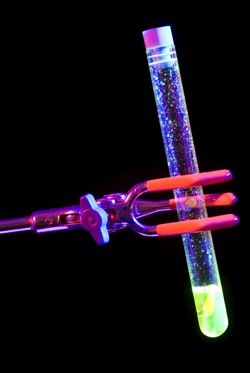A magazine where the digital world meets the real world.
On the web
- Home
- Browse by date
- Browse by topic
- Enter the maze
- Follow our blog
- Follow us on Twitter
- Resources for teachers
- Subscribe
In print
What is cs4fn?
- About us
- Contact us
- Partners
- Privacy and cookies
- Copyright and contributions
- Links to other fun sites
- Complete our questionnaire, give us feedback
Search:
Do not enter!

Humans have many great qualities, but we often tend to leave a bit of a mess. In the recent Pixar film, WALL-E, we meet a robot who helps to clean up after humans, but lots of robots already have WALL-E’s job for real.
Robots in Scotland
In Scotland a swarm of robots are helping to clean up the radioactive leftovers from a nuclear power station. Dounreay was an experimental fast breeder reactor. It used neutrons to turn uranium into plutonium, and the discoveries made there gave us new ways to produce electricity without burning fossil fuels. But, like most things in life, it came at a cost. At the end there were thousands of stainless steel tubes filled with radioactive uranium that needed to be moved to a special building to be examined, cleaned up, and even in some cases recycled. This is where the robots came in, because people wouldn’t want to be getting too close to the nuclear leftovers. The robot gang is made up of simple robots that are controlled by people at a distance, and some smarter robots that can do things for themselves. Robots that have some ability to act independently are called autonomous. Though autonomous robots aren’t yet able to decide everything they want to do, they can work out some things for themselves.
Reach out and touch me
Imagine you want your robot’s gripper to move to a nuclear rod and pick it up. You could watch how the gripper moves in real time by camera link and move the gripper with a joystick every bit of the way. Alternatively, you could just tell the robot to move its gripper to the position you want, and leave it to work out the movement for itself. For a robot, working out how to move an arm to a particular place in space is actually very tough.

Mostly armless
Let’s do a thought experiment. You’re inside a nuclear reactor and your arm is in a full plaster cast (what a nasty accident that was, get better soon). Your arm can’t bend, so now imagine having to get a firm hold of one of those uranium filled tubes. It’s going to be tough. Your arm can only move in very limited ways, and what if there are things in the way? Yipes, problems! After a visit to our thought experiment hospital, the cast is off and you can bend and shake your arm like normal. Now getting to a point in space is oh so much easier. You have more degrees of freedom to play with, the elbow bends again, your wrist rotates, and anything in the way is much less of a problem. More degrees of freedom means greater flexibility for your arm and it’s the same for a robot.
On the spot
The sorts of robots used in confined spaces like reactors need to have flexible arms, so they have motors that allow the arm to bend and turn like a human’s elbows, shoulder and wrist. Many robots try and produce movements similar to humans. After all, evolution has shown us it’s a fairly useful design. Some robots have more joints; after all there may be an even better solution than the human arm. (In fact other animals do have limbs with more degrees of freedom than us). But there is a problem. Back to a bit of arm experiment. Touch this full stop (.) with your index finger. Good, now keeping your finger on the full stop and your body stationary, move your arm, flex an elbow, twist a shoulder – there are loads of different ways that you can position your arm to touch the same point in space. Even though your arm has large parts that can’t change shape because of their rigid bones, our joints (moved and held in place by our muscles and tendons), give us all that wonderful flexibility.
Are we there yet?
Let’s run this back. Suppose you want to reach out and touch that full stop. Your brain uses the wonderful processing power in its visual cortex to work out where you want to move to, but another large brain area called the motor cortex works out exactly how the muscles and joints need to position themselves to make it happen. Engineers would say your brain solves a complex ‘inverse kinematics’ problem, namely, moving your finger to a particular position given the degrees of freedom and the muscles you have available. The same goes for autonomous robots. You tell the robot to move its gripper somewhere, and the computer takes the strain to work out how. These robots have to solve an inverse kinematics problem, this time with rigid steel ‘bones’ and electric motor ‘muscles’, but the computation is the same. In fact some robotics researchers have used information from the way humans solve this problem to help build robot arm computer control systems. These smart robots, which can do some of the thinking themselves, can help in nuclear reactors, outer space, deep under the sea, in fact in most environments where it would be dangerous for humans to go. Like WALL-E, they are built to help.


